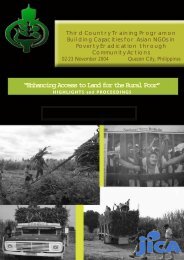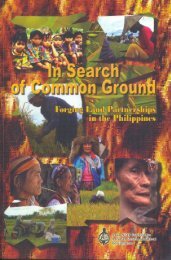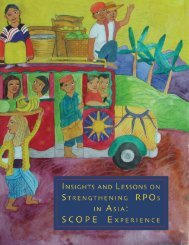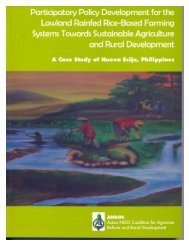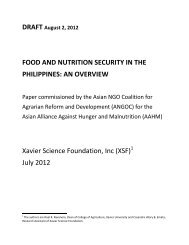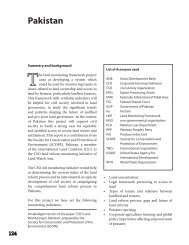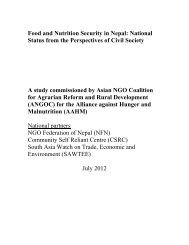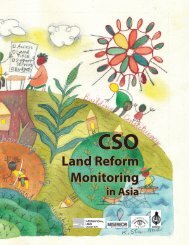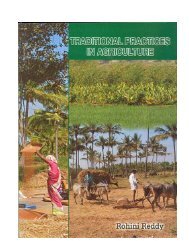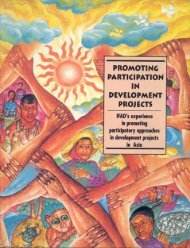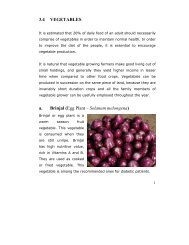Securing the Right to Land FULL - ANGOC
Securing the Right to Land FULL - ANGOC
Securing the Right to Land FULL - ANGOC
Create successful ePaper yourself
Turn your PDF publications into a flip-book with our unique Google optimized e-Paper software.
2. Presidential Order No. 135 (1972)<br />
Amended <strong>the</strong> EBSATA by authorizing <strong>the</strong> government <strong>to</strong><br />
lay claim <strong>to</strong> alluvion and diluvion land when such resurfaces,<br />
and <strong>to</strong> redistribute such <strong>to</strong> landless families.<br />
3. 1994 Amendment <strong>to</strong> <strong>the</strong> EBSATA<br />
Mandated that in <strong>the</strong> case of landholdings lost <strong>to</strong> erosion,<br />
<strong>the</strong> right, title, and interest of <strong>the</strong> tenant or his/her<br />
successor in interest are retained during <strong>the</strong> period of loss<br />
through erosion, but not exceeding 30 years.<br />
Vested Property Res<strong>to</strong>ration Act of 2001<br />
Abolished <strong>the</strong> Vested Property Act (VPA)—formerly <strong>the</strong> Enemy<br />
Property Act (EPA)—which dispossessed <strong>the</strong> Hindu population<br />
of <strong>the</strong>ir ancestral land during <strong>the</strong> war between Pakistan (of<br />
which Bangladesh used <strong>to</strong> be part) and India in 1965. Even<br />
after Bangladesh had declared its independence from Pakistan<br />
in 1971, <strong>the</strong> EPA was retained—renamed as VPA—and<br />
resulted in <strong>the</strong> confiscation of some 800,000 hectares of<br />
Hindu property. Around 0.75 million Hindu households were<br />
reportedly victimized by this law.<br />
Weakness/problems in implementation:<br />
> Even after <strong>the</strong> abolition of <strong>the</strong> VPA in 2001, <strong>the</strong> situation<br />
of Bangladesh’s Hindu population remains unchanged.<br />
Studies show that over a third of Hindu households have<br />
become landless and/or marginal landowners. Statistics<br />
also show a marked decline in <strong>the</strong> size of <strong>the</strong> Hindu<br />
population in Bangladesh: from 18.4% in 1961 <strong>to</strong> just<br />
9.2% in 2001.<br />
<strong>Land</strong> <strong>Right</strong>s and <strong>Land</strong> Management Projects<br />
Cluster Village Program (1988)<br />
Aimed <strong>to</strong> rehabilitate landless families by providing <strong>the</strong>m with<br />
homesteads on state land and by improving <strong>the</strong>ir socioeconomic<br />
status. In some cases, plots of land were awarded<br />
<strong>to</strong> families, under <strong>the</strong> name of both <strong>the</strong> husband and wife.<br />
During <strong>the</strong> periods 1988–1997 and 2000–2007, European<br />
financing helped <strong>to</strong> resettle more than 50,000 households<br />
on public land with 65% of <strong>the</strong>se receiving land titles.<br />
Char Development and Settlement Project (1987)<br />
Started in 1987 in <strong>the</strong> char areas in sou<strong>the</strong>astern Bangladesh;<br />
Aimed <strong>to</strong> settle landless persons on newly accreted land by<br />
providing support <strong>to</strong> <strong>the</strong> settled households. The project<br />
distributed some 40,000 hectares of khas land <strong>to</strong> 50,000<br />
landless families in <strong>the</strong> greater Noakhali districts.<br />
THE BACKPEDALLING STOPS<br />
49<br />
Computerization of <strong>Land</strong> Records Project<br />
Implemented as a pilot project <strong>to</strong> computerize land records<br />
in particular areas in Dhaka.<br />
Modernization of <strong>Land</strong> Administration Project (1995–2003)<br />
Implemented through technical assistance from <strong>the</strong> Asian<br />
Development Bank (ADB);<br />
Aimed <strong>to</strong> (1) identify <strong>the</strong> technological and human resource<br />
constraints <strong>to</strong> efficient land administration; (2) computerize<br />
property records; (3) improve <strong>the</strong> speed and quality of <strong>the</strong><br />
production of printed maps; and (4) au<strong>to</strong>mate <strong>the</strong> administration<br />
of <strong>the</strong> land development tax;<br />
The project showed that technical solutions alone are not<br />
enough <strong>to</strong> create a modern, transparent and efficient land<br />
administration system and that fundamental legal and institutional<br />
changes are necessary <strong>to</strong> operationalize <strong>the</strong> desired<br />
system.<br />
Access <strong>to</strong> <strong>Land</strong> of Marginalized<br />
Groups<br />
Ethnic Groups<br />
Some 1.2% of <strong>the</strong> country’s population is composed of ethnic<br />
minority populations (GoB 1994a). According <strong>to</strong> government<br />
records, <strong>the</strong>re are 27 ethnic or indigenous communities in<br />
Bangladesh; but different sources, including <strong>the</strong> leaders of <strong>the</strong><br />
ethnic groups, estimate <strong>the</strong> number at 45 and above.<br />
The ethnic minorities whom <strong>the</strong> Bangladesh government does<br />
not regard as indigenous <strong>to</strong> <strong>the</strong> country are classified in<strong>to</strong> two<br />
groups, according <strong>to</strong> <strong>the</strong>ir geographic location—<strong>the</strong> plains ethnic<br />
people and <strong>the</strong> hill ethnic people. There are 21 distinct ethnic<br />
communities in <strong>the</strong> plains who live along <strong>the</strong> borders of <strong>the</strong><br />
northwest, north, nor<strong>the</strong>ast and <strong>the</strong> north-central region of <strong>the</strong><br />
country. The hill ethnic people live in <strong>the</strong> Chittagong Hill Tracts<br />
(CHT), which is divided in<strong>to</strong> three districts—Rangamati,<br />
Khagrachari, and Bandarban.<br />
Access of Minority Groups <strong>to</strong> <strong>Land</strong> in <strong>the</strong> CHT<br />
Laws passed in 1865, 1875, and 1878 gave <strong>the</strong> state monopoly<br />
rights <strong>to</strong> different types of land and resources. In particular, a law<br />
passed in 1875 created two types of forest in <strong>the</strong> CHT, namely,<br />
Reserved forest (RF) and District Forest (DF). As a result of this<br />
law, 24% of <strong>the</strong> CHT was designated as RFs and off-limits <strong>to</strong> <strong>the</strong><br />
hill people. However, at <strong>the</strong> start of <strong>the</strong> 20 th century, hill people<br />
ASIAN NGO COALITION FOR AGRARIAN REFORM AND RURAL DEVELOPMENT



